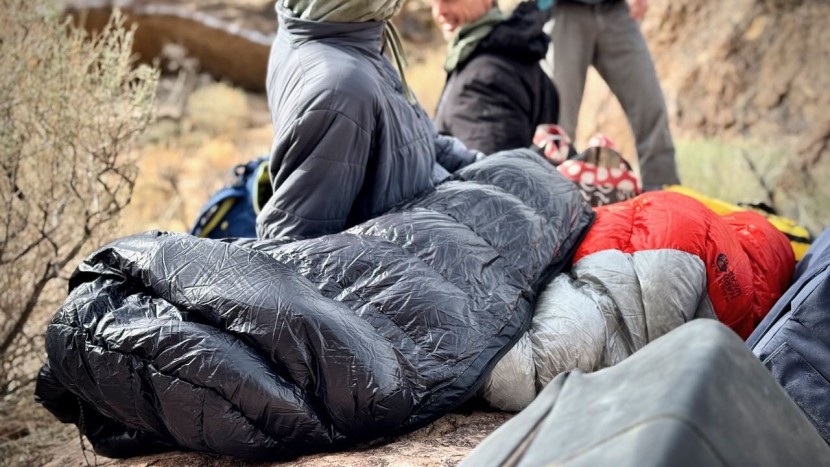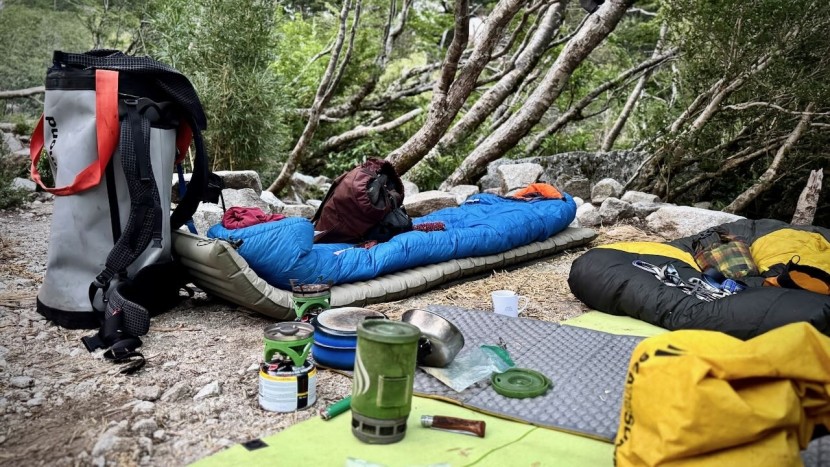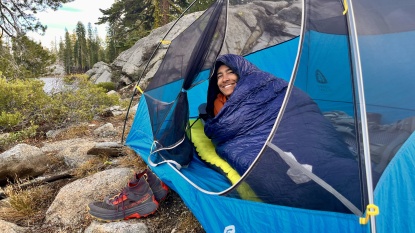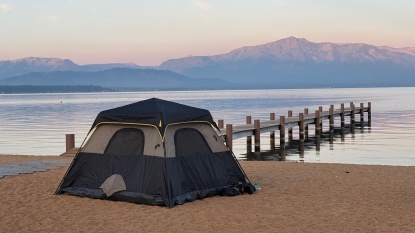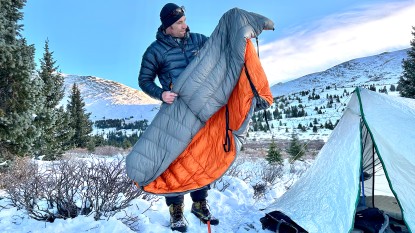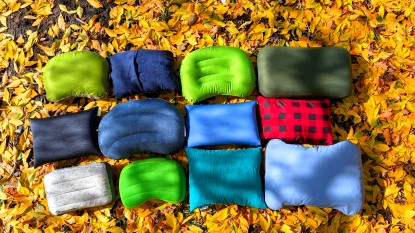Your sleeping bag is an essential part of your overnight backpacking system. It's considered one of the “Big Four” items that, as a backpacker, will have the greatest impact on your backpacking experience (along with your backpack, shelter, and sleeping pad). It affects the weight of your pack and how well you sleep — which both affect how efficient and energized you will be. The more you can do upfront to choose the right bag for your needs, the better your experience will be in the long run. In this article, we help you make the best choice for that big purchase and discuss why a women's specific bag may be the best choice for you.
The Basics
There is a lot to know about sleeping bags in general. Think about what you will be using yours for — are you trying to break speed records on the Pacific Crest Trail, or are you just making short overnight trips with friends? The lighter and more high-tech your bag is, the more expensive it will be. If you are car camping in warm climates, you don't need to worry about weight as much, but instead, you could purchase the most comfortable or least expensive bag on the market. If you are in the market for the lightest bag you can find, learn about the bags we evaluated in our Best Ultralight Sleeping Bag Review.
Related: Best Ultralight Sleeping Bag
Consider what fill material you want your bag to have. If you will not be wet-weather camping or plan on several multi-day backpacking trips, go with a down bag; it will be lighter for its warmth. If you are on a multi-week journey on the coast in November, choosing synthetic makes sense since it stays warmer when wet than down (while down loses more of its loft when wet). Synthetic bags are also typically less expensive and can be useful budget options. However, with new hydrophobic down technology, getting your down sleeping bag wet is slightly less of an issue, and many manufacturers are using this treated-down in their bags.
Other things to consider would be how warm your bag needs to be. If you will be winter camping or on a high altitude expedition, you should get a bag that is appropriate for that activity, probably rated to zero degrees Fahrenheit or lower — none of which are in this woman's review. We discuss these crucial factors in a separate buying advice article geared toward cold conditions.
Also, consider what shape and style will work best, and what features you want. If you or your children are only camping out in the backyard or going to the campground for the weekend, check out our review of sleeping bags for camping. However, if you're hopping on the John Muir Trail for three weeks, you'll probably want a lightweight backpacking sleeping bag like one of the down bags in our women's review or something from the backpacking sleeping bag review. The features we like are stash pockets, draft collars, and soft liner materials.
Why Do Women Sleep Colder?
First, let's acknowledge that everyone's bodies are different and many factors affect our internal temperatures, including diet, age, fitness, and how much sleep we typically get. It is, however, common knowledge that women tend to feel colder more often than men, especially when it comes to sleeping outdoors. It's not because we're wimpier. Believe it or not, it's because we have more evenly distributed body fat. We have a layer of fat on our bodies that men do not — that's why our skin has a softer feel and look overall.
Because of this wonderful fat layer, women are better at moderating body temperatures and conserving heat than men. The problem is that when keeping the core heated, the body pulls warm blood away from the hands and feet. Extremity temperatures significantly vary when compared to internal organs, and this, in turn, dictates how hot or cold we feel. Women tend to get cold extremities more often and therefore, feel colder. Differences in metabolism between genders may also play a role. But you know how the saying goes, ladies, cold hands = warm heart. Check out this cool video from the BBC on this topic.
Possibly because of the extra insulation, most of the women's bags we tested are not any lighter than the men's versions. They tend to be the same weight as the corresponding men's bags. Unfortunately, weight savings are not a benefit of getting a women's bag like it is with women's sleeping pads, but usually, you're getting a warmer bag for the same weight.
There is an unfortunate phenomenon that we call “shrink it and pink it,” which happens with some women's gear, meaning the manufacturer has not put any real thought into how to make a product work better for a woman. So, who has done their research and created a great women's bag, and who has not?
On the other hand, more manufacturers are creating very high-end products but are not including a women-specific bag in their lineup. Instead, manufacturers who are smart and still want to tap into this market are creating high-end bags in “short” lengths, often the same dimensions as women's specific bags.
Female Specific Features
Now that we know a little more about women's physiology, it may seem more obvious what to look for in a women's specific bag. Many manufacturers are starting to get it, too, and we've seen significant increases in high-quality bags added to our selection. Women's products are starting to catch up with the unisex market and are coming in hot with lightweight materials, high-quality down, and creative features to give you a better night's sleep.
When it comes to differences between men's and women's sleeping bags, the bag's warmth is the primary factor, which you can tailor in three ways. The first is to resize the bag to fit a woman's frame. Typical women's specific bags are made to fit a woman who is about 5'6", while a men's regular is made to fit a 6" to 6'2" man. The average woman in the United States is right around 5'4".
- Length/fit
- More insulation per square inch
- Location of extra insulation
Women's bags are also cut differently to fit a female form better - they are a bit wider in the hips (an average of 2 inches) and narrower in the shoulder (an average of 2-6 inches less). A better fit helps your body warm the air inside the bag more efficiently. If your bag is too large, your body won't be able to warm up all that air quickly, leaving you cold, so get a bag that fits you. We like the Feathered Friends website that offers a very informative page on selecting the right sleeping bag for you - they lay out the different types and temperature ratings well.
Secondly, look for a bag that has more insulation. Many women's models have more insulation in them than the same model in the men's version. The EN rating system also helps to determine if the bag is the right temperature initially. The first comfort rating temperature represents the temperature at which a woman would find the bag comfortable. However, we take this rating with a grain of salt. It's helpful when comparing EN-rated products, but many smaller companies still do not EN test their products because it is too expensive, and they have determined their ratings by field testing.
Thirdly, as mentioned above, women feel colder because their hands and feet are colder. Some manufacturers have realized this, too, and decided to be strategic about where they put the extra insulation: the feet. Some higher-end sleeping bags even allow the option of continuous baffles so that you can easily shake the extra insulation down into the feet or other specific heat-loss areas specific to your body.
Selecting the Right Bag For You
There are hundreds, if not thousands, of bags on the market, and all are made for different purposes and sold at different price points. OutdoorGearLab has tested over a hundred of these bags for different activities over the years. The bags in this review are women's specific, typically mummy-style, and predominantly for backpacking or car camping. Keep reading to learn more about the considerations you should consider when checking out the bags we tested.
Activity
Will you be carrying this bag on your back for many days in a row, or will you be throwing it in your boat or car? The weight of your bag is an important factor when choosing a product, but not so much for activities that you won't be carrying it long distances.
Insulation Type
Down or Synthetic? The age-old question. Down insulation is typically lighter, more durable, and more compressible, but will lose its loft, and therefore, a significant amount of its warmth when it gets wet. Synthetic insulation maintains its loft when wet, but is typically heavier, less durable, bulkier than down insulation, and less expensive.
Most down bags in this review have some water-resistant or “hydrophobic down” coating to compete with synthetic bags. Hydrophobic down undergoes a waterproofing treatment that tries to create the perfect solution to all insulation problems. Manufacturers tend to have their proprietary version of hydrophobic down treatment. The insulation is still down, so it is light and compressible, but supposedly it is more resilient to moisture and helps the down maintain its loft longer. The verdict is still out on this technology, but more and more companies are using it in their products.
In general, the synthetic bags in this review are at a disadvantage when it comes to the rating metrics since they are all inherently bulkier and heavier — we prefer down sleeping bags for backpacking. If you can afford it, we would recommend going with down. They are warmer, lighter, and more durable over time; in short, a worthy investment.
Sleeping Systems
Some manufacturers are moving towards bags with no insulation on the backside of the bags instead of sleeves for sleeping pads. The thought behind this is that when a bag is laid on, the insulation's loft is compressed and therefore ineffective. The weight goes down by removing the insulation along the back of the bag, trusting your sleeping pad (which will hopefully have a high R-Value) will insulate that side of you. While we are not sold on these sleeping systems and think they can sometimes lead to a colder, more uncomfortable sleep (stretching out your bag and restricting you from wrapping it tightly around yourself), the pad sleeves add extra weight.
Caring for your Sleeping Bag
You are making a significant investment in your new bag, and it should be able to last you for several years. Most manufacturers provide some cotton or mesh storage sack with your bag, as it is essential to store it fully lofted when you're not carrying it around. This practice helps with the longevity of your investment. Keeping the down compressed damages it over time, even more so with synthetic fibers. The more you compress synthetic fibers, the more they break down, resulting in less loft each time. This process means that a down bag is ultimately more durable and retains its loft and warmth over time.
The best thing you can do for your down bag is to wash it once in a while. When down gets dirty, it does not fluff up as much and will not keep you as warm. When you wash your bag, use a front-loading washing machine and a detergent made for cleaning technical down; products like Nikwax Down Wash can be used to rejuvenate your down bag. Don't be afraid to throw your bag in the dryer. Get yourself two or three clean tennis balls and toss them in there with it to break up the clumps of down and tumble until it is totally dry. You will be amazed at how much loftier your bag will be after a good wash. Washing your synthetic model is even simpler and will help it with its loft as well. Doing these few things will help the longevity and ensure you get the best value from your investment.
Lastly, if the shell or liner of your sleeping bag rips, the faster you can repair it, the less insulation you lose. If you're next to a sewing machine and know how to use it, that's the most permanent fix. However, if you are out in the backcountry, having a strip of Tenacious Tape in your pack can seal up a hole well enough until you get back home.
Conclusion
The bottom line is that there is less selection in women's specific bags. If you are looking for a very specialized type of bag, like an ultralight quilt for fastpacking, or have a specific brand you love, you might have to go for a unisex bag — but make sure that it is one that fits you and isn't too big! Many smaller craft companies have a range of sizes, including options that are small enough for women. Regardless, the principles for buying a sleeping bag for a woman (even if you're buying a unisex one) are the same. Decide what you want it for, what materials you prefer, and how much you want to pay. Then, get one that fits you properly and is warm enough — potentially with extra insulation in strategic locations.





